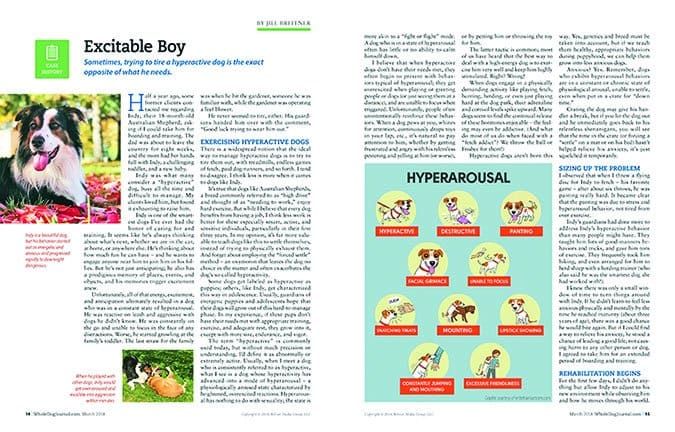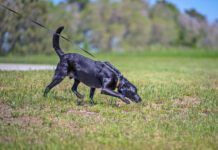Training Editor Pat Miller writes:
I would like to make a few comments regarding the article, “Training an Over-Aroused Dog,” in the March issue of WDJ. For starters, kudos to author Jill Breitner for her excellent work with Indy. Highly aroused dogs can be frustrating to live with and challenging to work with. The significant improvement in his behavior is clear evidence that she was doing all the right things.
That said, there are many very energetic dogs who can and do benefit from an increase in appropriate types of exercise, and I would encourage dog owners to not rule out exercise as a possible solution to their highly energetic dog. There are different ways to exercise, and sometimes it’s a matter of finding the right way to exercise your dog. For example:
1. If I use a fetch-game of some sort for an energetic dog, I also build in various impulse-control elements, such as having the dog sit or lie down in order to prompt me to throw the ball, and teaching a “Wait” after the ball is thrown until she gets the release cue. Eventually I may even teach the dog a “release/down/wait/release again” sequence.
2. For dogs who do get too aroused for fetch – or for those who won’t play fetch – an off-leash hike (or a hike on a long line) can be a less-arousing but still highly effective way to provide adequate exercise.
WDJ March 2018 issue

3. Finally, exercise doesn’t have to be highly physical. Scent work is surprisingly good exercise for dogs. Because they are so good with their noses, we tend to think scent work is easy for them, but it is, in fact, very tiring – which is why wild dogs, despite having excellent noses, will use vision to hunt as much as possible. Shaping and other mind games can also be very effective at tiring out a dog who is bouncing off the walls.
In my experience, many dogs deemed “hyperactive” can and do thrive on an increase in appropriate exercise. I have had numerous clients successfully help their high-energy dogs by doing so and have fostered a variety of shelter dogs labeled “hyperactive” who settled nicely after a few weeks here on the farm.
In fact, I don’t even use the term “hyperactive” with my clients’ dogs unless I am seeing the rare dog who truly appears clinically, pathologically, unable to control their level of activity. My concern is that it gives humans an excuse for having an out-of-control dog, as opposed to one who just needs more of an investment of their humans’ time and energy.
Author/trainer Jill Breitner responds:
Indy was labeled hyperactive by his owners, who increased and increased his exercise in an effort to tire him out and calm him down. In his case, it was the wrong thing to do, because the label was wrong to begin with.
Indy actually isn’t hyperactive or over-energetic. He was in a constant state of hyperarousal, and that’s why more exercise wasn’t what he needed, though it often is what other highly active dogs need. Physiologically, Indy was in a state of chronic stress. He needed less exercise and more rest, so that he could destress and find some peace and calm in body and mind.
I agree with Pat that exercise is crucial for dogs and that highly energetic dogs will usually benefit from increased exercise. However, the thing that many people get wrong is to increase exercise at the expense of mental stimulation and training. As Pat points out, appropriate exercise is key.
I still threw a flying disc for Indy and I still hiked with him, but I didn’t let him get “over threshold” – the point at which a dog goes from showing no anxiety to showing signs of anxiety: panting, agitation, inability to focus, inability to settle.
Pat’s suggestion of using scent work, shaping, and other “brain games” to help tire out highly energetic dogs is great. Scent work is particularly good for mentally and physically tiring out energetic dogs, as well as hyperaroused dogs like Indy. Indy loves scent work and is able to stay under threshold when engaged in this task.
There are many ways to add mental stimulation to a simple game of fetch. For example, we can ask the dog to jump onto a platform and lie down before we throw a disc for him. We can ask him to go through an agility tunnel before catching the ball. The important thing to recognize is when the dog is getting over threshold and stopping the game or reducing its intensity until the dog calms down. If you know the signs of hyperarousal, depicted in the infographic in the original article, then you will be more able to help your dog.
Every dog benefits from exercise, but it must be looked at as part of a program of meeting the dog’s mental, physical, and emotional needs.






